Högsta betyg
Säker tillgång till kostnadsfria tester nu Prova först, sedan studera!
4.9/5.0 - Googles recensioner
4.90/5.0från 507 Recensioner av betrodda butiker
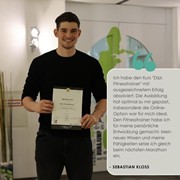
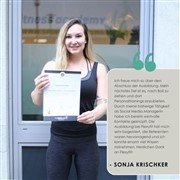
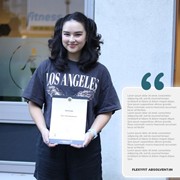

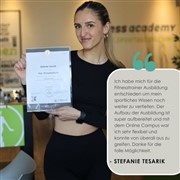
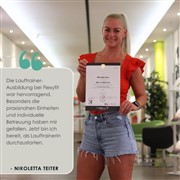
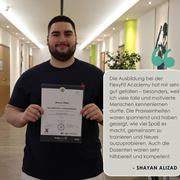

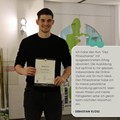
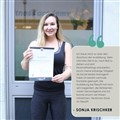

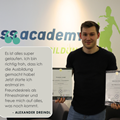
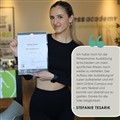


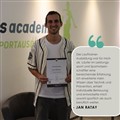

€ 1.290,- | Distansutbildning
» VårPaket för lärande
Information om kursen
Erkänd och certifierad
Våra akademiker, partners och vänner säger
Vårt team ger dig gärna råd när som helst via telefon, chatt eller personligen
Fitness- och avslappningspaket
Vid första anblicken verkar fitness och avkoppling vara två helt olika koncept. Men i själva verket kan de komplettera och till och med stödja varandra perfekt.
Som fitness- och avslappningstränare har du en fantastisk möjlighet att hjälpa människor att bli både fysiskt och mentalt friska och balanserade.
Vårt utbildningspaket Fitness & Relaxation, som består av kurserna Fitness Trainer och Relaxation Trainer B Licence, kan genomföras oberoende av tid och plats med vårt distansutbildningsalternativ. Detta utbildningspaket ger dig allt du behöver: gedigen teoretisk kunskap, praktisk erfarenhet och massor av tips och tricks för din egen träning.
Du kommer att lära dig att använda och justera träningsutrustning korrekt så att du kan coacha dina kunder korrekt under utrustningsträning. Inom området avkoppling får du praktisk input om avkopplingsmetoder, mental och autogen träning, progressiv muskelavslappning och stressteori så att du kan ge dina kunder kompetent stöd.
Omfattning av lärande
560 E
EQF-nivå
Utbildningen är inriktad på EQF-nivå 3 »
Kursstart
Omedelbart möjligt
Inlärningsvariant
Distansutbildning
Möjligt
Undervisningsspråk


Även om du kanske inte omedelbart inser det, går fitness och avslappning ofta hand i hand. Sport kan hjälpa till att bekämpa stress och spänningar om den används på rätt sätt. Avslappningsmetoder kan i sin tur förbereda dig mentalt för tävlingar eller hjälpa dig att varva ner efter ett träningspass.
Utbildningspaketet för fitness och avslappning gör dig till en licensierad avslappnings- och fitnesstränare oberoende av tid och plats. Lär dig flexibelt, när och var du vill. Vi stöder dig med förberedda manus och många videor som är tillgängliga för dig var som helst och när som helst. Dokumenten kommer att följa med dig resten av livet, även efter att du har avslutat din utbildning!
Förutom omfattande utbildning i stressteori lär vårt distansutbildningsprogram dig också strategier för att minska och undvika stress. Förutom teori finns det också gott om praktik. Med progressiv muskelavslappning och autogen träning introducerar vi dig till två välkända och effektiva avslappningstekniker i mer detalj. Vi kommer också att introducera dig till specifika övningar och användningen av fitnessutrustning i många videor.
Våra intyg är giltiga i hela världen och utfärdas i olika versioner. På begäran kan du få vårt intyg på flera språk (DE, EN, ES), med landsspecifik information och med eller utan ett tryckt betyg.
Alla dessa varianter kan laddas ner kostnadsfritt online. Dessutom får du ett valfritt certifikat tryckt på specialpapper med präglat tryck.
Följande intyg utfärdas (på flera språk DE, EN, ES):
Vi hjälper dig gärna via telefon, e-post eller chatt . Du kanske hittar svaret på din fråga i vår allmänna FAQ, FAQ för fitnesstränare eller FAQ för avslappningstränare.
Omfattning av lärande
200
Expertis inom idrott
276
eLearning | Självstudier
12
Forskning om litteratur
60
Praktiskt förverkligande
12
Ytterligare uppgifter och tentor
Våra utbildningsprogram är i allmänhet berättigade till finansiering. Det relevanta finansieringsorganet kommer att avgöra om du är berättigad till finansiering.
Vi hjälper dig gärna att sammanställa all nödvändig kursinformation som du behöver för din finansieringsansökan.
Naturligtvis finns vi till hands för att ge dig råd genom hela processen och stödja dig från den första förfrågan till inlämnandet av din ansökan. Kontakta oss - vi ser till att du är så väl förberedd som möjligt!
Visa alla kapitel i ämnena

Vi utbildar de bästa tränarna inom fitnessbranschen. Vi stöttar och vägleder våra studenter från början till slut och långt därefter.
Funktionell anatomi är grunden för varje tränare inom sport- och hälsosektorn. Denna specialiserade kurs ger dig en omfattande inblick i människokroppens anatomi och ger dig fördjupade kunskaper.
Kursen är utformad för att vara så levande och begriplig som möjligt med hjälp av olika undervisnings- och inlärningstekniker - anpassade till behoven hos fitness- och personliga tränare.
Målet är att se sambanden mellan olika rörelsesekvenser och att förstå de viktigaste latinska facktermerna.

I Allmän idrottsnutrition introduceras våra deltagare till grunderna i näringslära.
Som grund diskuteras sammansättningen av vår kost med makro- och mikronäringsämnen samt vattenbalansen. För att förstå olika inbördes förhållanden diskuteras energibalansen i detalj.
Dessutom diskuteras effekten av de enskilda näringskomponenterna på människokroppen och deras betydelse inom id rotten.

Eftersom skador är vardag smat inom idrotten är det viktigt att känna till orsakerna till och konsekvenserna av de vanligaste skadorna. Om det värsta inträffar måste den personliga tränaren kunna reagera snabbt och korrekt!
En förståelse för olika skademönster hjälper också till att förhindra att de uppstår från första början.

I många företag har hälsofrämjande arbete på arbetsplatsen blivit en populär metod för att förbättra de anställdas hälsa, förebygga sjukdomar och därmed förbättra deras välbefinnande.
Varför hälsofrämjande på arbetsplatsen är så viktigt visas i en introduktion till hälsofrämjande på arbetsplatsen, utmaningar med hälsofrämjande på arbetsplatsen presenteras och vanliga organisatoriska sjukdomar diskuteras.
Kursdeltagarna kommer också att lära sig om framgångsfaktorerna för hälsofrämjande på arbetsplatsen, fördelarna för anställda och organisationen och, naturligtvis, bästa praxis och verktyg.
För detta ändamål presenteras olika verksamhetsområden och åtgärder och kursdeltagarna får också veta hur man kommer in i sådana företag, utarbetar koncept och klargör andra viktiga organisatoriska frågor.
Kursdeltagarna får se praktiska exempel och får också möjlighet att tillämpa det de har lärt sig i grupparbeten.

Syftet med den kundorienterade arbetsenheten är att ge kursdeltagarna en inblick i marknadsföring så att de senare kan positionera sig väl på marknaden som tränare och göra det lättare för dem att komma in på marknaden.
För detta ändamål kommer vi först att definiera vad marknadsföring egentligen är och varför det också är relevant för personliga tränare.
Dessutom förklaras vanliga marknadsföringstermer som USP, fördelar, positionering etc. och olika marknadsföringsmodeller som SMART-formeln, 4P-marknadsföringsmixen och andra.
Naturligtvis glöms inte kommunikationen mellan tränare och kunder bort i denna enhet. Olika aspekter av kommunikation och regler för framgångsrik kommunikation introduceras och exempel visas.
I slutet av denna enhet ska kursdeltagarna kunna positionera sig själva och sin produkt eller tjänst på marknaden med hjälp av en marknadsföringsstrategi och sälja den framgångsrikt.

Goda kunskaper om människans fysiologi och kroppens funktioner är en nödvändig förutsättning för att alla tränare som arbetar med idrott ska kunna utföra sitt arbete på rätt sätt.
Denna kurs kommer att göra den mänskliga organismens inbördes relationer"begripliga" för dig. Res med oss genom människokroppen och förstå organismens funktioner för din nya karriär inom idrotten.
Ämnet utforskar muskelns energiförsörjning, det kardiovaskulära systemet och andningssystemet på ett praktiskt och spännande sätt.
En bra idrottsutbildning börjar i grunden med anatomi och fysiologi.

Kursen förbereder deltagarna för att kunna kommunicera framgångsrikt med kunder på alla nivåer. Dessutom kommer deltagarna att få analysera sina egna mål och motiv för att bättre förstå sina kunders.
Att sätta rätt mål och ge feedback på rätt sätt är också en del av kursen!
Stresshantering och olika inlärningsstrategier introduceras också för deltagarna så att de kan tillämpa dem efter kursen.

I den första delen av träningslära lär man sig grunderna i träning, t.ex. träningsprinciper, principer för träningsorganisation, träningsmetoder och faktorer som påverkar den idrottsliga prestationen.
Eftersom prestation, prestationsdiagnostik, träning och tävling är nära förknippade med varandra, undervisas de också på motsvarande sätt i kursen.
I den andra delen av träningsläran definieras och bedöms träning som en komplex handlingsprocess och i samband med planering, genomförande och utvärdering.
En viktig del av träningsteorin är fortfarande utformningen av träningsplaner, vilket lärs ut i praktiken med exempel på möjligheterna att utforma en träningsplan.
För att gå ännu djupare in i träningsvetenskapen har vi samarbetat med internationella toppföreläsare som Prof. em. Dr phil. Dr med. Dr h.c. Jürgen Weineck, och vi har även utvecklat en videoworkshop om ämnet höjdträning.
Visa alla kapitel i ämnena

Ämnet "Styrketräning med hjälp av redskap" ingår i licensutbildningen till fitnessinstruktör B och handlar om systematisk styrketräning på stationära träningsredskap. Fokus ligger på rörelsekontroll, belastningskontroll och individuell anpassning av träningen till olika målgrupper.
Vid styrketräning med hjälp av redskap belastas musklerna via mekaniskt styrda rörelsebanor. Detta möjliggör en målinriktad och kontrollerad belastning av enskilda muskelgrupper och är en säker träningsform, särskilt för nybörjare, personer med begränsad rörlighet eller i rehabiliteringssammanhang.
Följande ämnen behandlas som en del av ämnet:
Innehållet i detta ämne utgör en grund för praktiskt arbete i fitnesscenter eller hälsofaciliteter. Den utexaminerade kan skapa och instruera individuella träningsprogram med hjälp av redskap och genomföra dem på ett säkerhetsmedvetet sätt.

Att genomföra praktiska träningspass är en viktig del för att erhålla B-licensen för konditionstränare.
Att lära sig människokroppens anatomi, i synnerhet musklernas ursprung och insättning, är viktigt för att förbereda sig optimalt inför examinationen. Det är lika viktigt att dokumentera de praktiska övningarna. Dokumentationen ger en översikt över de utbildningstillfällen som genomförts, de mål som uppnåtts och deltagarnas personliga erfarenheter.
30 utbildningsenheter planeras där deltagarna ska omsätta de kunskaper de har lärt sig i praktiken. Var och en av dessa enheter registreras av deltagarna på eget ansvar. På så sätt ska de visa att de kan förbereda, genomföra och analysera ett träningspass självständigt.
Fitness Trainer B-licens är en av våra mindre utbild ningar för att skaffa sig grundläggande kunskaper inom områdena styrketräning med stora redskap, anatomi, fysiologi, träningslära och mycket mer.
Det är viktigt att lägga upp utbildningen på ett sådant sätt att deltagarna förstår övningarna och kan utföra dem på ett säkert sätt. Deltagarna får en guide för de praktiska sessionerna, som de kan använda för att registrera träningsprotokollet.
Bevis på de slutförda enheterna måste tillhandahållas, till exempel skriftlig bekräftelse från en utbildare eller skärmdumpar från en träningsapp.
Visa alla kapitel i ämnena


Syftet med de praktiska sessionerna är att öva och befästa det vi har lärt oss. Du kan spela in dina egna träningspass samt träningspass med vänner och släktingar.
Träningen kan t.ex. vara progressiv muskelavslappning, mental eller autogen träning eller andningsövningar. Deltagarna kan antingen utföra dessa enheter själva eller tillsammans med vänner/släktingar. Målet är att utveckla en känsla för avslappningsmetoderna så att de senare kan instrueras kompetent som utbildare.

Betydelsen och fördelarna med mental träning har under de senaste årtiondena fått genomslag på många områden, oavsett om det gäller idrott, arbete eller privatliv.
Mental träning erbjuder olika tekniker för att optimera koncentrationen och prestationen hos varje individ. Tekniker som autogen träning, visualisering, målsättningsträning etc. kan användas för att identifiera och utnyttja oupptäckt potential.
När det gäller avslappning hjälper mental träning till att sakta ner den outtröttliga tankeprocessen, att förstå den bättre och därmed göra avslappning möjlig överhuvudtaget. Kursen är uppdelad i teoretiska och praktiska delar, med gott om utrymme för självkännedom.


Tillgängliga utbildningsvarianter av denna utbildning
Undervisningsspråk
Specialiserad modul
Expertis inom sport (online)
Idrottslig kompetens (närvaro)
Sportexpertis Full HD utbildningsvideor
Full HD LearningVideos Avslappningstränare B
Full HD utbildningsvideor fitness trainer B licens
Inkluderad kurs
Inlärningsvariant
Inlärningsmetod
Auditiv och visuell inlärningstyp
Kommunikativ och motorisk inlärartyp
Tid för inlärning
Skript och dokument som PDF
Föreläsningar kan bokas som praktiska dagar
Support via Onlinecampus, e-post, chatt, telefon.
WhatsApp och support på plats
Test av examensprov
NADA Österrike
Höjdträning - Prof. DDDr Weineck
SPK mellanliggande examen online
Slutlig examination
Certifikat i DE, EN, SP
Certifikat giltigt över hela världen och obegränsat i tid
Online campus tillgängligt för hela livet
Gratis demo-konto / testpaket
Kopior av intyg kan laddas ner som PDF
Certifikat med autentisering (QR-kod)
Finansieringsmöjligheter
Utbildningsledighet (AT)
Marknadsföring för företag
Främjande av egenföretagare
Kursrådgivning
Kostnadsberäkning för finansierande organ
Arbetsförmedling
Omfattande vidareutbildningsprogram
Absolut bästa pris och utbud av tjänster
EN
Online + teknisk diskussion
Valfritt bokningsbar
314
66
55
B licens
online
visuell
rekommenderad
lämplig
Flexibel
postningsbar
Flexibelt datum
upp till 100
icke-bindande
Det finns en mängd olika finansieringsalternativ för utbildningsprogram på Flexyfit Sports Academy. Statsspecifik och EU-finansiering samt skatterelaterade alternativ utgör grunden för detta.
Vi vill dock påpeka att respektive finansieringsorgan är ensamt ansvarigt för att besluta om tilldelningen eller storleken på finansieringen.
Vi hjälper dig gärna att hitta en lämplig finansiär och sammanställer all kursinformation som du behöver för en finansieringsansökan. Du måste själv skicka in ansökan till finansieringsorganisationen.
Beroende på finansieringsorganisation betalas utbildningskostnaderna antingen direkt efter att finansieringsansökan har bekräftats (t.ex. AMS) eller återbetalas helt eller delvis efter att utbildningen har slutförts (t.ex. waff). Vänligen kontakta de finansierande organisationerna för att få information om hur finansieringen fungerar.
Ja, de flesta av våra kurser är lämpliga för studieledighet.
Om du vill fortsätta din utbildning utan att säga upp ditt anställningsavtal kan du komma överens med din arbetsgivare om tjänstledighet. Det innebär att du är ledig från ditt arbete under den tid som utbildningen pågår.
Planera din utbildningsledighet med oss nu! Vi klargör gärna dina individuella utbildningsbehov tillsammans med dig i ett personligt och icke-bindande samtal.
Du kan ta ut din utbildningsledighet under högst 1 år inom 4 år - det finns 3 alternativ:
Det är viktigt att din arbetsgivare samtycker till att du tar ut utbildningsledighet. Du ska styrka de utbildningsplaner som vi utfärdar i en omfattning av 20 timmar per vecka vid utbildningsledighet på heltid eller minst 10 timmar vid utbildningsledighet på deltid.
Du måste regelbundet lämna bevis på hur din utbildning fortskrider. Till exempel i form av prov eller närvarobekräftelse, som du får från oss.
En konditionstränares ansvarsområden är varierande och beror bland annat på var och i vilket anställningsförhållande de är anställda eller egenföretagare.
I båda fallen ligger fokus naturligtvis på kondition. Som anställd på ett fitnesscenter kan du också vara ansvarig för administrativa uppgifter i administrationen eller instruera nya fitnesscentermedlemmar.
Som personlig tränare kontrollerar du dina kunders konditionsnivå och sätter upp mål, skapar träningsplaner för dem och förklarar styrke- och uthållighetsutrustning och konditionsövningar. Du följer sedan med dina kunder på deras resa, motiverar dem och ser till att de uppnår sina mål.
Om du blir gruppträningstränare kommer du att leda gruppklasser för sporter som pilates, yoga eller aerobics. För detta är det tillrådligt att gå en ytterligare specialiseringskurs.
Som fast anställd fitnessinstruktör kan du förvänta dig en ingångslön på mellan 18 600 € och 21 900 € brutto per år. Med några års yrkeserfarenhet ökar löneintervallet sedan till 23 200-25 000 euro per år.
Vid egenföretagande beror lönen på hur många kunder tränaren har och hur priserna sätts. Utöver detta tillkommer naturligtvis lokalhyra, såvida du inte fokuserar på hembesök och utomhusträning.
Fitnesstränare arbetar ofta på fitnesscenter, som fast anställda eller frilansare. Fitnesstränare behövs dock också i wellnessföretag som hotell eller hälsocenter, eller i sportklubbar.
Egenföretagande som personlig tränare är också ett populärt alternativ, med många möjliga platser. Förutom i egna lokaler är det också vanligt med utomhusträning eller hembesök hos kunder. På vissa gym kan du också avtala om att använda lokalerna mot hyra.
På grund av konkurrensen är det inte längre så lätt att starta en egen fitnessstudio. Det är därför många fitnesstränare går in i områden som hälsofrämjande på arbetsplatsen eller idrottsutveckling, där de till exempel ger råd om utformningen av fitnesscenter och idrottsplatser och hallar.
Avslappningstränare lär människor tekniker och strategier för att minska stress och visar sina kunder hur de kan hjälpa sig själva i stressiga situationer. De använder till exempel övningar för att minimera stimuli, andningstekniker, stretching och muskelavslappning. Mental träning används också vid stresshantering. Till exempel är visualisering och målsättningsträning samt autogen träning viktiga komponenter i utbildningen för att bli en avslappningstränare.
Det finns stora skillnader i inkomst beroende på om avslappningstränare är egenföretagare eller anställda av ett företag.
I medelstora företag är en månadslön på 1 500 euro eller mer normal, men som intern avslappningstränare i ett större företag kan bruttomånadsinkomsten vara så hög som 2 800 euro.
De högsta inkomsterna kan uppnås genom egenföretagande, där 3000 € per månad är genomförbart med tillräckligt många kunder. Om du är egenföretagare måste du dock också äga eller hyra din egen lokal och ta hand om bokföring och förvaltning.
Avslappningstränare har möjlighet att bli egenföretagare och lära ut avslappningstekniker till individer i sin egen praktik, samt att arbeta i grupper. Du kan till exempel hålla kurser eller undervisa på institutioner. Skolor och daghem har också ofta ett behov av autogen träning idag.
Vissa företag anställer också en intern avslappningstränare för sina anställda för att hjälpa till med arbetsrelaterad stress, så alternativen är varierade och kan kombineras flexibelt.
Vi listar regelbundet jobbannonser från fitnessstudior på vår Sportkarriere-plattform. Där kan du ansöka direkt om jobb som fitnesstränare, filialchef, instruktör eller studioanställd.

Även om du kanske inte omedelbart inser det, går fitness och avslappning ofta hand i hand. Sport kan hjälpa till att bekämpa stress och spänningar om den används på rätt sätt. Avslappningsmetoder kan i sin tur förbereda dig mentalt för tävlingar eller hjälpa dig att varva ner efter ett träningspass.
Utbildningspaketet för fitness och avslappning gör dig till en licensierad avslappnings- och fitnesstränare oberoende av tid och plats. Lär dig flexibelt, när och var du vill. Vi stöder dig med förberedda manus och många videor som är tillgängliga för dig var som helst och när som helst. Dokumenten kommer att följa med dig resten av livet, även efter att du har avslutat din utbildning!
Förutom omfattande utbildning i stressteori lär vårt distansutbildningsprogram dig också strategier för att minska och undvika stress. Förutom teori finns det också gott om praktik. Med progressiv muskelavslappning och autogen träning introducerar vi dig till två välkända och effektiva avslappningstekniker i mer detalj. Vi kommer också att introducera dig till specifika övningar och användningen av fitnessutrustning i många videor.
Våra intyg är giltiga i hela världen och utfärdas i olika versioner. På begäran kan du få vårt intyg på flera språk (DE, EN, ES), med landsspecifik information och med eller utan ett tryckt betyg.
Alla dessa varianter kan laddas ner kostnadsfritt online. Dessutom får du ett valfritt certifikat tryckt på specialpapper med präglat tryck.
Följande intyg utfärdas (på flera språk DE, EN, ES):
Vi hjälper dig gärna via telefon, e-post eller chatt . Du kanske hittar svaret på din fråga i vår allmänna FAQ, FAQ för fitnesstränare eller FAQ för avslappningstränare.
Omfattning av lärande
200
Expertis inom idrott
276
eLearning | Självstudier
12
Forskning om litteratur
60
Praktiskt förverkligande
12
Ytterligare uppgifter och tentor
Våra utbildningsprogram är i allmänhet berättigade till finansiering. Det relevanta finansieringsorganet kommer att avgöra om du är berättigad till finansiering.
Vi hjälper dig gärna att sammanställa all nödvändig kursinformation som du behöver för din finansieringsansökan.
Naturligtvis finns vi till hands för att ge dig råd genom hela processen och stödja dig från den första förfrågan till inlämnandet av din ansökan. Kontakta oss - vi ser till att du är så väl förberedd som möjligt!
Visa alla kapitel i ämnena

Vi utbildar de bästa tränarna inom fitnessbranschen. Vi stöttar och vägleder våra studenter från början till slut och långt därefter.
Funktionell anatomi är grunden för varje tränare inom sport- och hälsosektorn. Denna specialiserade kurs ger dig en omfattande inblick i människokroppens anatomi och ger dig fördjupade kunskaper.
Kursen är utformad för att vara så levande och begriplig som möjligt med hjälp av olika undervisnings- och inlärningstekniker - anpassade till behoven hos fitness- och personliga tränare.
Målet är att se sambanden mellan olika rörelsesekvenser och att förstå de viktigaste latinska facktermerna.

I Allmän idrottsnutrition introduceras våra deltagare till grunderna i näringslära.
Som grund diskuteras sammansättningen av vår kost med makro- och mikronäringsämnen samt vattenbalansen. För att förstå olika inbördes förhållanden diskuteras energibalansen i detalj.
Dessutom diskuteras effekten av de enskilda näringskomponenterna på människokroppen och deras betydelse inom id rotten.

Eftersom skador är vardag smat inom idrotten är det viktigt att känna till orsakerna till och konsekvenserna av de vanligaste skadorna. Om det värsta inträffar måste den personliga tränaren kunna reagera snabbt och korrekt!
En förståelse för olika skademönster hjälper också till att förhindra att de uppstår från första början.

I många företag har hälsofrämjande arbete på arbetsplatsen blivit en populär metod för att förbättra de anställdas hälsa, förebygga sjukdomar och därmed förbättra deras välbefinnande.
Varför hälsofrämjande på arbetsplatsen är så viktigt visas i en introduktion till hälsofrämjande på arbetsplatsen, utmaningar med hälsofrämjande på arbetsplatsen presenteras och vanliga organisatoriska sjukdomar diskuteras.
Kursdeltagarna kommer också att lära sig om framgångsfaktorerna för hälsofrämjande på arbetsplatsen, fördelarna för anställda och organisationen och, naturligtvis, bästa praxis och verktyg.
För detta ändamål presenteras olika verksamhetsområden och åtgärder och kursdeltagarna får också veta hur man kommer in i sådana företag, utarbetar koncept och klargör andra viktiga organisatoriska frågor.
Kursdeltagarna får se praktiska exempel och får också möjlighet att tillämpa det de har lärt sig i grupparbeten.

Syftet med den kundorienterade arbetsenheten är att ge kursdeltagarna en inblick i marknadsföring så att de senare kan positionera sig väl på marknaden som tränare och göra det lättare för dem att komma in på marknaden.
För detta ändamål kommer vi först att definiera vad marknadsföring egentligen är och varför det också är relevant för personliga tränare.
Dessutom förklaras vanliga marknadsföringstermer som USP, fördelar, positionering etc. och olika marknadsföringsmodeller som SMART-formeln, 4P-marknadsföringsmixen och andra.
Naturligtvis glöms inte kommunikationen mellan tränare och kunder bort i denna enhet. Olika aspekter av kommunikation och regler för framgångsrik kommunikation introduceras och exempel visas.
I slutet av denna enhet ska kursdeltagarna kunna positionera sig själva och sin produkt eller tjänst på marknaden med hjälp av en marknadsföringsstrategi och sälja den framgångsrikt.

Goda kunskaper om människans fysiologi och kroppens funktioner är en nödvändig förutsättning för att alla tränare som arbetar med idrott ska kunna utföra sitt arbete på rätt sätt.
Denna kurs kommer att göra den mänskliga organismens inbördes relationer"begripliga" för dig. Res med oss genom människokroppen och förstå organismens funktioner för din nya karriär inom idrotten.
Ämnet utforskar muskelns energiförsörjning, det kardiovaskulära systemet och andningssystemet på ett praktiskt och spännande sätt.
En bra idrottsutbildning börjar i grunden med anatomi och fysiologi.

Kursen förbereder deltagarna för att kunna kommunicera framgångsrikt med kunder på alla nivåer. Dessutom kommer deltagarna att få analysera sina egna mål och motiv för att bättre förstå sina kunders.
Att sätta rätt mål och ge feedback på rätt sätt är också en del av kursen!
Stresshantering och olika inlärningsstrategier introduceras också för deltagarna så att de kan tillämpa dem efter kursen.

I den första delen av träningslära lär man sig grunderna i träning, t.ex. träningsprinciper, principer för träningsorganisation, träningsmetoder och faktorer som påverkar den idrottsliga prestationen.
Eftersom prestation, prestationsdiagnostik, träning och tävling är nära förknippade med varandra, undervisas de också på motsvarande sätt i kursen.
I den andra delen av träningsläran definieras och bedöms träning som en komplex handlingsprocess och i samband med planering, genomförande och utvärdering.
En viktig del av träningsteorin är fortfarande utformningen av träningsplaner, vilket lärs ut i praktiken med exempel på möjligheterna att utforma en träningsplan.
För att gå ännu djupare in i träningsvetenskapen har vi samarbetat med internationella toppföreläsare som Prof. em. Dr phil. Dr med. Dr h.c. Jürgen Weineck, och vi har även utvecklat en videoworkshop om ämnet höjdträning.
Visa alla kapitel i ämnena

Ämnet "Styrketräning med hjälp av redskap" ingår i licensutbildningen till fitnessinstruktör B och handlar om systematisk styrketräning på stationära träningsredskap. Fokus ligger på rörelsekontroll, belastningskontroll och individuell anpassning av träningen till olika målgrupper.
Vid styrketräning med hjälp av redskap belastas musklerna via mekaniskt styrda rörelsebanor. Detta möjliggör en målinriktad och kontrollerad belastning av enskilda muskelgrupper och är en säker träningsform, särskilt för nybörjare, personer med begränsad rörlighet eller i rehabiliteringssammanhang.
Följande ämnen behandlas som en del av ämnet:
Innehållet i detta ämne utgör en grund för praktiskt arbete i fitnesscenter eller hälsofaciliteter. Den utexaminerade kan skapa och instruera individuella träningsprogram med hjälp av redskap och genomföra dem på ett säkerhetsmedvetet sätt.

Att genomföra praktiska träningspass är en viktig del för att erhålla B-licensen för konditionstränare.
Att lära sig människokroppens anatomi, i synnerhet musklernas ursprung och insättning, är viktigt för att förbereda sig optimalt inför examinationen. Det är lika viktigt att dokumentera de praktiska övningarna. Dokumentationen ger en översikt över de utbildningstillfällen som genomförts, de mål som uppnåtts och deltagarnas personliga erfarenheter.
30 utbildningsenheter planeras där deltagarna ska omsätta de kunskaper de har lärt sig i praktiken. Var och en av dessa enheter registreras av deltagarna på eget ansvar. På så sätt ska de visa att de kan förbereda, genomföra och analysera ett träningspass självständigt.
Fitness Trainer B-licens är en av våra mindre utbild ningar för att skaffa sig grundläggande kunskaper inom områdena styrketräning med stora redskap, anatomi, fysiologi, träningslära och mycket mer.
Det är viktigt att lägga upp utbildningen på ett sådant sätt att deltagarna förstår övningarna och kan utföra dem på ett säkert sätt. Deltagarna får en guide för de praktiska sessionerna, som de kan använda för att registrera träningsprotokollet.
Bevis på de slutförda enheterna måste tillhandahållas, till exempel skriftlig bekräftelse från en utbildare eller skärmdumpar från en träningsapp.
Visa alla kapitel i ämnena


Syftet med de praktiska sessionerna är att öva och befästa det vi har lärt oss. Du kan spela in dina egna träningspass samt träningspass med vänner och släktingar.
Träningen kan t.ex. vara progressiv muskelavslappning, mental eller autogen träning eller andningsövningar. Deltagarna kan antingen utföra dessa enheter själva eller tillsammans med vänner/släktingar. Målet är att utveckla en känsla för avslappningsmetoderna så att de senare kan instrueras kompetent som utbildare.

Betydelsen och fördelarna med mental träning har under de senaste årtiondena fått genomslag på många områden, oavsett om det gäller idrott, arbete eller privatliv.
Mental träning erbjuder olika tekniker för att optimera koncentrationen och prestationen hos varje individ. Tekniker som autogen träning, visualisering, målsättningsträning etc. kan användas för att identifiera och utnyttja oupptäckt potential.
När det gäller avslappning hjälper mental träning till att sakta ner den outtröttliga tankeprocessen, att förstå den bättre och därmed göra avslappning möjlig överhuvudtaget. Kursen är uppdelad i teoretiska och praktiska delar, med gott om utrymme för självkännedom.


Tillgängliga utbildningsvarianter av denna utbildning
Undervisningsspråk
Specialiserad modul
Expertis inom sport (online)
Idrottslig kompetens (närvaro)
Sportexpertis Full HD utbildningsvideor
Full HD LearningVideos Avslappningstränare B
Full HD utbildningsvideor fitness trainer B licens
Inkluderad kurs
Inlärningsvariant
Inlärningsmetod
Auditiv och visuell inlärningstyp
Kommunikativ och motorisk inlärartyp
Tid för inlärning
Skript och dokument som PDF
Föreläsningar kan bokas som praktiska dagar
Support via Onlinecampus, e-post, chatt, telefon.
WhatsApp och support på plats
Test av examensprov
NADA Österrike
Höjdträning - Prof. DDDr Weineck
SPK mellanliggande examen online
Slutlig examination
Certifikat i DE, EN, SP
Certifikat giltigt över hela världen och obegränsat i tid
Online campus tillgängligt för hela livet
Gratis demo-konto / testpaket
Kopior av intyg kan laddas ner som PDF
Certifikat med autentisering (QR-kod)
Finansieringsmöjligheter
Utbildningsledighet (AT)
Marknadsföring för företag
Främjande av egenföretagare
Kursrådgivning
Kostnadsberäkning för finansierande organ
Arbetsförmedling
Omfattande vidareutbildningsprogram
Absolut bästa pris och utbud av tjänster
EN
Online + teknisk diskussion
Valfritt bokningsbar
314
66
55
B licens
online
visuell
rekommenderad
lämplig
Flexibel
postningsbar
Flexibelt datum
upp till 100
icke-bindande
Det finns en mängd olika finansieringsalternativ för utbildningsprogram på Flexyfit Sports Academy. Statsspecifik och EU-finansiering samt skatterelaterade alternativ utgör grunden för detta.
Vi vill dock påpeka att respektive finansieringsorgan är ensamt ansvarigt för att besluta om tilldelningen eller storleken på finansieringen.
Vi hjälper dig gärna att hitta en lämplig finansiär och sammanställer all kursinformation som du behöver för en finansieringsansökan. Du måste själv skicka in ansökan till finansieringsorganisationen.
Beroende på finansieringsorganisation betalas utbildningskostnaderna antingen direkt efter att finansieringsansökan har bekräftats (t.ex. AMS) eller återbetalas helt eller delvis efter att utbildningen har slutförts (t.ex. waff). Vänligen kontakta de finansierande organisationerna för att få information om hur finansieringen fungerar.
Ja, de flesta av våra kurser är lämpliga för studieledighet.
Om du vill fortsätta din utbildning utan att säga upp ditt anställningsavtal kan du komma överens med din arbetsgivare om tjänstledighet. Det innebär att du är ledig från ditt arbete under den tid som utbildningen pågår.
Planera din utbildningsledighet med oss nu! Vi klargör gärna dina individuella utbildningsbehov tillsammans med dig i ett personligt och icke-bindande samtal.
Du kan ta ut din utbildningsledighet under högst 1 år inom 4 år - det finns 3 alternativ:
Det är viktigt att din arbetsgivare samtycker till att du tar ut utbildningsledighet. Du ska styrka de utbildningsplaner som vi utfärdar i en omfattning av 20 timmar per vecka vid utbildningsledighet på heltid eller minst 10 timmar vid utbildningsledighet på deltid.
Du måste regelbundet lämna bevis på hur din utbildning fortskrider. Till exempel i form av prov eller närvarobekräftelse, som du får från oss.
En konditionstränares ansvarsområden är varierande och beror bland annat på var och i vilket anställningsförhållande de är anställda eller egenföretagare.
I båda fallen ligger fokus naturligtvis på kondition. Som anställd på ett fitnesscenter kan du också vara ansvarig för administrativa uppgifter i administrationen eller instruera nya fitnesscentermedlemmar.
Som personlig tränare kontrollerar du dina kunders konditionsnivå och sätter upp mål, skapar träningsplaner för dem och förklarar styrke- och uthållighetsutrustning och konditionsövningar. Du följer sedan med dina kunder på deras resa, motiverar dem och ser till att de uppnår sina mål.
Om du blir gruppträningstränare kommer du att leda gruppklasser för sporter som pilates, yoga eller aerobics. För detta är det tillrådligt att gå en ytterligare specialiseringskurs.
Som fast anställd fitnessinstruktör kan du förvänta dig en ingångslön på mellan 18 600 € och 21 900 € brutto per år. Med några års yrkeserfarenhet ökar löneintervallet sedan till 23 200-25 000 euro per år.
Vid egenföretagande beror lönen på hur många kunder tränaren har och hur priserna sätts. Utöver detta tillkommer naturligtvis lokalhyra, såvida du inte fokuserar på hembesök och utomhusträning.
Fitnesstränare arbetar ofta på fitnesscenter, som fast anställda eller frilansare. Fitnesstränare behövs dock också i wellnessföretag som hotell eller hälsocenter, eller i sportklubbar.
Egenföretagande som personlig tränare är också ett populärt alternativ, med många möjliga platser. Förutom i egna lokaler är det också vanligt med utomhusträning eller hembesök hos kunder. På vissa gym kan du också avtala om att använda lokalerna mot hyra.
På grund av konkurrensen är det inte längre så lätt att starta en egen fitnessstudio. Det är därför många fitnesstränare går in i områden som hälsofrämjande på arbetsplatsen eller idrottsutveckling, där de till exempel ger råd om utformningen av fitnesscenter och idrottsplatser och hallar.
Avslappningstränare lär människor tekniker och strategier för att minska stress och visar sina kunder hur de kan hjälpa sig själva i stressiga situationer. De använder till exempel övningar för att minimera stimuli, andningstekniker, stretching och muskelavslappning. Mental träning används också vid stresshantering. Till exempel är visualisering och målsättningsträning samt autogen träning viktiga komponenter i utbildningen för att bli en avslappningstränare.
Det finns stora skillnader i inkomst beroende på om avslappningstränare är egenföretagare eller anställda av ett företag.
I medelstora företag är en månadslön på 1 500 euro eller mer normal, men som intern avslappningstränare i ett större företag kan bruttomånadsinkomsten vara så hög som 2 800 euro.
De högsta inkomsterna kan uppnås genom egenföretagande, där 3000 € per månad är genomförbart med tillräckligt många kunder. Om du är egenföretagare måste du dock också äga eller hyra din egen lokal och ta hand om bokföring och förvaltning.
Avslappningstränare har möjlighet att bli egenföretagare och lära ut avslappningstekniker till individer i sin egen praktik, samt att arbeta i grupper. Du kan till exempel hålla kurser eller undervisa på institutioner. Skolor och daghem har också ofta ett behov av autogen träning idag.
Vissa företag anställer också en intern avslappningstränare för sina anställda för att hjälpa till med arbetsrelaterad stress, så alternativen är varierade och kan kombineras flexibelt.
Vi listar regelbundet jobbannonser från fitnessstudior på vår Sportkarriere-plattform. Där kan du ansöka direkt om jobb som fitnesstränare, filialchef, instruktör eller studioanställd.

2 weeks ago
Sehr gut organisiertes Team, unkomplizierte Bedienung von Online Unterricht, vielseitiges Informatives Skriptum :) All in all Top !
postat på
2 weeks ago
Ich bin sehr angetan von Flexyfit, immer nette und hilfsbereite Leute. Sehr sympatisch. Vielen Dank, für Eure super Betreuung.
postat på
3 weeks ago
Super Ausbildung und mega nette Leute. Man merkt, wie viel Wert darauf gelegt wird den Kursteilnehmern das nötige Wissen verständlich zu vermitteln. Ich durfte sogar freundlicherweise einen Kurs komplett kostenlos nachholen, nachdem etwas problematische und störende Teilnehmer in meiner Gruppe waren. Ich werde 100%ig in Zukunft noch weitere Kurse bei euch machen, weil das Lernen allen voran dank des freundlichen Personals extremen Spaß macht!
postat på
3 weeks ago
Das gesamte Team von flexyfit ist überaus freundlich, prompt und hilfsbereit. Die Vortragenden sind kompetent und gehen auf die Kursteilnehmer ein. Sämtliche Lernunterlagen wurden übersichtlich und ausreichend detailliert zur Verfügung gestellt. Durch die zusätzlichen Videos ist für jeden Lerntyp etwas dabei. Alles in allem verliefen Ausbildung und Prüfung top. Ich kann flexyfit jedenfalls weiterempfehlen und werde weitere Ausbildungen gerne wieder bei Euch buchen und weiterempfehlen!
postat på
a months ago
Ein super Team - kompetent, freundlich, stets hilfsbereit und unterstützend - hat die praxisnahe Ausbildung hervorragend begleitet. Sehr zu empfehlen! :)
postat på
a months ago
Super Betreuung und umfangreiche Kursinhalte. Sehr zu empfehlen!
postat på
a months ago
Die Ausbildung zum Fitnesstrainer B-Lizenz hat mir dort sehr viel Spaß gemacht. Die gestellten Lehrmaterialien sind super und einwandfrei. Ich habe dort sehr viel neues gelernt und war immer mit Freude an der Sache. Das Team ist super und ist bei Rückfragen immer für einen da!
postat på
a month ago
Das Beste, was mir passieren konnte, ist diese Akademie. Der Zugang zu den Teilnehmern ist hervorragend. Alle Mitarbeiter sind sehr kompetent, sehr professionell und sehr freundlich. Ein Mensch kann so viel lernen, dass es unbeschreiblich gut ist. Ich würde es jedem empfehlen. Als ich in Österreich ankam, war ich auf der Suche nach so etwas und zum Glück habe ich diese Akademie gefunden und mich ohne zu zögern für den Kurs angemeldet. All das, was wir als Gegenleistung bekommen, ist 100-mal mehr wert als das, was wir bezahlen. Unbeschreibliche Erfahrung, unbeschreibliche Menschen, noch einmal und noch 1000 Mal sage ich: Danke für alles, danke für dieses unbeschreibliche Erlebnis. DANKE, DANKE, DANKE <3
postat på
a months ago
Ich konnte im Rahmen meiner Ausbildung bei der Flexyfit Academy sehr viel neues lernen und konnte mich mit meinem ausgewählten Lehrgang einer neuen anspruchsvollen Herausforderung stellen. Die Struktur der Ausbildungen ist sehr verständlich und übersichtlich gestaltet, sodass man ohne Probleme das Fernstudium alleine meistern kann. Bei Fragen, Unklarheiten oder vereinzelten Problemen war das Team der Academy immer schnell zur Seite und man konnte immer eine gemeinsame Lösung finden. Hier und da hätte ich mir noch etwas mehr Praxisbezug gewünscht. Nichtsdestotrotz habe ich mich immer sehr wohl gefühlt, habe tolle Referenten gehabt und mit meinem Abschluss zum Dipl. Medical Sportbetreuer stehen mir nun viele neue Türen offen :)
postat på
2 months ago
Konnte meinen gewählten Lehrgang sehr gut und zügig abschließen. Das Team ist sehr schnell und kukant und man bekommt immer eine gute Lösung angeboten, sollte es Unklarheiten geben. Werde bei Gelegenheit wieder buchen und kann die Akademie empfehlen!
postat på
"Flexyfit - flexibelt lärande, anpassat för framtiden."

Välj en inlärningsvariant eller ange en söktext!